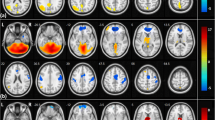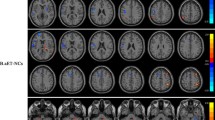Abstract
Individuals with essential tremor (ET) have postural and active movement abnormalities. Disturbances in the cerebello-thalamo-cortical circuit may contribute to the several motor symptoms of ET. Resting state fMRI provides a valuable, noninvasive tool to study intrinsic activation in the human brain, particularly in the brains of individuals with neuropsychiatric diseases. To investigate the low frequency oscillation features of intrinsic activation in ET in this study, we performed a resting state fMRI analysis in 24 patients with ET and 23 healthy controls. The amplitudes of low frequency fluctuation (ALFF) were analyzed. When compared with healthy controls, patients showed significantly enhanced ALFF in the bilateral cerebral cortex, which is related to motor function, including the pre- and post-central gyrus, supplementary motor area and paracentral lobule. The larger ALFF value in the right precentral gyrus is related to a longer duration of tremor. The decreased ALFF in the bilateral cerebellum was also observed in patients. In addition, aberrant ALFF in the right cerebellar tonsil was negatively associated with the duration of tremor. Our findings suggest that abnormalities exist in the intrinsic activation of brain regions in patients with ET. These findings provide noninvasive evidence that supports the hypothesis that the abnormality of intrinsic activity in the cerebello-cerebral cortex pathway could be associated with the motor-related symptoms of ET. Furthermore, the duration of a tremor might relate to the severity of the alterations to the motor system of ET.



Similar content being viewed by others
References
Bagepally BS et al (2012) Decrease in cerebral and cerebellar gray matter in essential tremor: a voxel-based morphometric analysis under 3T MRI. J Neuroimaging 22(3):275–278
Bhalsing KS, Saini J, Pal PK (2013) Understanding the pathophysiology of essential tremor through advanced neuroimaging: a review. J Neurol Sci 335(1–2):9–13
Cao W et al (2014) Resting-state functional connectivity in anterior cingulate cortex in normal aging. Front Aging Neurosci 6:280
Chen X et al (2015) Functional disconnection between the visual cortex and the sensorimotor cortex suggests a potential mechanism for self-disorder in schizophrenia. Schizophr Res 166:151–157
Deuschl G, Bain P, Brin M (1998) Consensus statement of the Movement Disorder Society on tremor. Ad Hoc Scientific Committee. Mov Disord 13(Suppl 3):2–23
Fang W et al (2013) Abnormal regional homogeneity in patients with essential tremor revealed by resting-state functional MRI. PLoS One 8(7):e69199
Fox MD, Raichle ME (2007) Spontaneous fluctuations in brain activity observed with functional magnetic resonance imaging. Nat Rev Neurosci 8(9):700–711
Fox MD et al (2005) The human brain is intrinsically organized into dynamic, anticorrelated functional networks. Proc Natl Acad Sci USA 102(27):9673–9678
Gallea C et al (2015) Intrinsic signature of essential tremor in the cerebello-frontal network. Brain 138:2920–2933
Grimaldi G, Manto M (2013) Is essential tremor a Purkinjopathy? The role of the cerebellar cortex in its pathogenesis. Mov Disord 28(13):1759–1761
Haier RJ et al (2003) Temporal cortex hypermetabolism in Down syndrome prior to the onset of dementia. Neurology 61(12):1673–1679
Hansel C (2009) Reading the clock: how Purkinje cells decode the phase of olivary oscillations. Neuron 62(3):308–309
Hoptman MJ et al (2010) Amplitude of low-frequency oscillations in schizophrenia: a resting state fMRI study. Schizophr Res 117(1):13–20
Jarque CM, Bera AK (1980) Efficient tests for normality, homoscedasticity and serial independence of regression residuals. Econ Lett 6(3):255–259
Jiang S et al (2016) Altered local spontaneous brain activity in juvenile myoclonic epilepsy: a preliminary resting-state fMRI study. Neural Plast 2016:7
Klein JC et al (2011) Diffusion tensor imaging of white matter involvement in essential tremor. Hum Brain Mapp 32(6):896–904
Li Q et al (2015) Altered resting state functional network connectivity in children absence epilepsy. J Neurol Sci 354(1–2):79–85
Liao W et al (2010) Altered functional connectivity and small-world in mesial temporal lobe epilepsy. PLoS One 5(1):e8525
Louis ED (2010) Essential tremor: evolving clinicopathological concepts in an era of intensive post-mortem enquiry. Lancet Neurol 9(6):613–622
Louis ED (2014a) `Essential tremor’ or `the essential tremors’: is this one disease or a family of diseases? Neuroepidemiology 42(2):81–89
Louis ED (2014b) Understanding essential tremor: progress on the biological front. Curr Neurol Neurosci Rep 14(6):450
Louis ED, Ferreira JJ (2010) How common is the most common adult movement disorder? Update on the worldwide prevalence of essential tremor. Mov Disord 25(5):534–541
Louis ED et al (2007) Neuropathological changes in essential tremor: 33 cases compared with 21 controls. Brain 130(Pt 12):3297–3307
Luo C et al (2011) Altered functional connectivity in default mode network in absence epilepsy: a resting-state fMRI study. Hum Brain Mapp 32(3):438–449
Luo C et al (2012a) Disrupted functional brain connectivity in partial epilepsy: a resting-state fMRI study. PLoS One 7(1):e28196
Luo C et al (2012b) Resting state basal ganglia network in idiopathic generalized epilepsy. Hum Brain Mapp 33(6):1279–1294
Luo C et al (2015) Altered structural and functional feature of striato-cortical circuit in benign epilepsy with centrotemporal spikes. Int J Neural Syst 25:1550027
Maier MA et al (2002) Differences in the corticospinal projection from primary motor cortex and supplementary motor area to macaque upper limb motoneurons: an anatomical and electrophysiological study. Cereb Cortex 12(3):281–296
Menon RS (2002) Postacquisition suppression of large-vessel BOLD signals in high-resolution fMRI. Magn Reson Med 47(1):1–9
Neely KA et al (2014) Functional brain activity relates to 0–3 and 3–8 Hz force oscillations in essential tremor. Cereb Cortex 25:4191–4202
O’Hearn E, Molliver ME (1997) The olivocerebellar projection mediates ibogaine-induced degeneration of Purkinje cells: a model of indirect, trans-synaptic excitotoxicity. J Neurosci 17(22):8828–8841
Raethjen J, Deuschl G (2012) The oscillating central network of essential tremor. Clin Neurophysiol 123(1):61–64
Sharifi S et al (2014) Neuroimaging essentials in essential tremor: a systematic review. Neuroimage Clin 5:217–231
Song XW et al (2011) REST: a toolkit for resting-state functional magnetic resonance imaging data processing. PLoS One 6(9):e25031
Tan Y et al (2015) Altered brain activation in early drug-naive Parkinson’s disease during heat pain stimuli: an fMRI study. Parkinsons Dis 2015:273019
Wang Z et al (2011) Spatial patterns of intrinsic brain activity in mild cognitive impairment and Alzheimer’s disease: a resting-state functional MRI study. Hum Brain Mapp 32(10):1720–1740
Xue K et al (2014) Diffusion tensor tractography reveals disrupted structural connectivity in childhood absence epilepsy. Epilepsy Res 108(1):125–138
Zang YF et al (2007) Altered baseline brain activity in children with ADHD revealed by resting-state functional MRI. Brain Dev 29(2):83–91
Zhang Z et al (2010) fMRI study of mesial temporal lobe epilepsy using amplitude of low-frequency fluctuation analysis. Hum Brain Mapp 31(12):1851–1861
Acknowledgments
We thank all subjects for their participation in this study and two anonymous reviewers for their nice comments. We thank Prof. Rongbo Liu in Sichuan University for his methodological assistance, and Dr. Andreas Altorfer for his English language assistance.
Author information
Authors and Affiliations
Corresponding author
Ethics declarations
Conflict of interest
None of the authors has any conflict of interest to disclose.
Rights and permissions
About this article
Cite this article
Yin, W., Lin, W., Li, W. et al. Resting State fMRI Demonstrates a Disturbance of the Cerebello-Cortical Circuit in Essential Tremor. Brain Topogr 29, 412–418 (2016). https://doi.org/10.1007/s10548-016-0474-6
Received:
Accepted:
Published:
Issue Date:
DOI: https://doi.org/10.1007/s10548-016-0474-6




